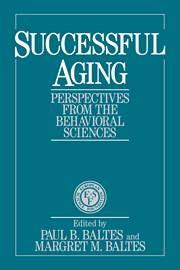Book contents
- Frontmatter
- Contents
- List of contributors
- Foreword
- Preface
- 1 Psychological perspectives on successful aging: The model of selective optimization with compensation
- 2 Medical perspectives upon successful aging
- 3 Successful aging in a post-retired society
- 4 The optimization of cognitive functioning in old age: Predictions based on cohort-sequential and longitudinal data
- 5 The optimization of episodic remembering in old age
- 6 Peak performance and age: An examination of peak performance in sports
- 7 Personal control over development and quality of life perspectives in adulthood
- 8 Successful mastery of bereavement and widowhood: A life-course perspective
- 9 The Bonn Longitudinal Study of Aging: Coping, life adjustment, and life satisfaction
- 10 Risk and protective factors in the transition to young adulthood
- 11 Avoiding negative life outcomes: Evidence from a forty-five year study
- 12 Developmental behavioral genetics and successful aging
- Name index
- Subject index
10 - Risk and protective factors in the transition to young adulthood
Published online by Cambridge University Press: 22 March 2010
- Frontmatter
- Contents
- List of contributors
- Foreword
- Preface
- 1 Psychological perspectives on successful aging: The model of selective optimization with compensation
- 2 Medical perspectives upon successful aging
- 3 Successful aging in a post-retired society
- 4 The optimization of cognitive functioning in old age: Predictions based on cohort-sequential and longitudinal data
- 5 The optimization of episodic remembering in old age
- 6 Peak performance and age: An examination of peak performance in sports
- 7 Personal control over development and quality of life perspectives in adulthood
- 8 Successful mastery of bereavement and widowhood: A life-course perspective
- 9 The Bonn Longitudinal Study of Aging: Coping, life adjustment, and life satisfaction
- 10 Risk and protective factors in the transition to young adulthood
- 11 Avoiding negative life outcomes: Evidence from a forty-five year study
- 12 Developmental behavioral genetics and successful aging
- Name index
- Subject index
Summary
Change continues throughout the life cycle so that changes for better or for worse are always possible. It is this continuing potential for change that means that at no time of life is a person invulnerable to every possible adversity and also that at no time of life is a person impermeable to favourable influence.
John Bowlby, 1988Introduction
The twin themes of consistency and change, continuity and discontinuity, lie at the heart of studies of human development. Both are ever-present possibilities, but some phases of the life course highlight the tensions between them with special clarity. Developmental transitions – times of greater than usual change, whether prompted by biological maturation, psychological growth, or changes in social roles and statuses – are among the most important of these. Such periods place often heavy demands on the individual for adaptation to new conditions but also hold within them the potential for new beginnings, opportunities to overcome earlier difficulties and to set out on new developmental trajectories (Emde & Harmon, 1984). Examining the processes that make for more and less successful negotiation of such transitions, that maintain vulnerabilities or protect against them at such periods, may thus constitute one fruitful approach to the study of successful aging.
Our aim in this essay is to consider risk and protective processes of this kind for one of the major transition periods in the life span: that marking the entry to adult life.
- Type
- Chapter
- Information
- Successful AgingPerspectives from the Behavioral Sciences, pp. 296 - 331Publisher: Cambridge University PressPrint publication year: 1990
- 18
- Cited by



